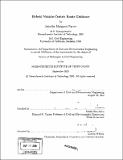Hybrid vehicle-centric route guidance
Author(s)
Farver, Jennifer M. (Jennifer Margaret), 1976-
DownloadFull printable version (11.89Mb)
Other Contributors
Massachusetts Institute of Technology. Dept. of Civil and Environmental Engineering.
Advisor
Moshe Ben-Akiva.
Terms of use
Metadata
Show full item recordAbstract
This thesis proposes a hybrid route guidance system in which predictive guidance is generated in a centralized layer and revised in a reactive, decentralized layer that resides on-board the vehicle. This hybrid approach is intended to improve guidance quality by balancing the ability of the centralized layer to generate consistent guidance with the ability of the decentralized layer to respond rapidly to incidents. Centralized guidance is computed using a rolling-horizon Dynamic Traffic Assignment routine based on the Method of Successive Averages. This guidance is disseminated to equipped vehicles in the form of prescribed paths, which may be subsequently revised by an on-board decentralized layer. This decentralized layer revises only the local portion of the vehicle's path in order to limit the potential negative impact of its myopic reactive algorithm. The layer uses a simple splitting algorithm in order to heuristically balance demand on alternate paths. Both layers utilize data collected by guided vehicles. The centralized layer uses position data from guided vehicles. The decentralized layer uses local arc travel time data which is shared among guided vehicles. (cont.) This approach follows the vision of a vehicle-centric route guidance system whose design is focused on the vehicle, rather than on stationary components. In order to test the performance of the proposed system, a small test network is simulated in a simple network simulator. The primary experimental questions are: whether the hybrid system provides higher quality route guidance than either a fully centralized or fully decentralized system; and how hybrid guidance quality is affected by various parameters of the system and the testing environment. Results of testing confirm that the hybrid system provides higher quality guidance than either centralized or decentralized systems in most scenarios; in no scenario is the hybrid system found to perform measurably worse than the centralized or decentralized system. The greatest benefits of the hybrid system are found to be in incident scenarios, supporting the hypothesis that the decentralized layer may aid incident response.
Description
Thesis (Ph. D.)--Massachusetts Institute of Technology, Dept. of Civil and Environmental Engineering, 2005. Includes bibliographical references (p. 223-228).
Date issued
2005Department
Massachusetts Institute of Technology. Department of Civil and Environmental EngineeringPublisher
Massachusetts Institute of Technology
Keywords
Civil and Environmental Engineering.